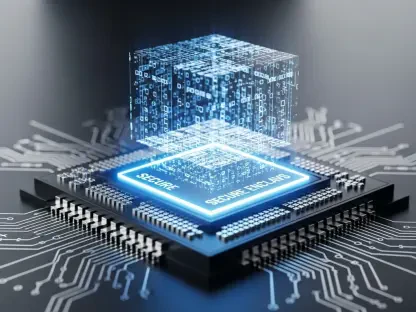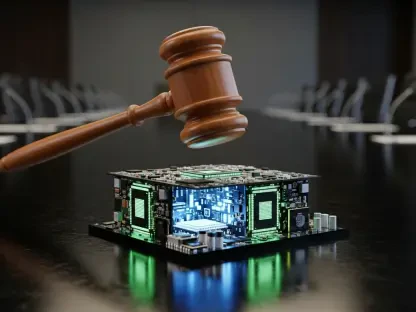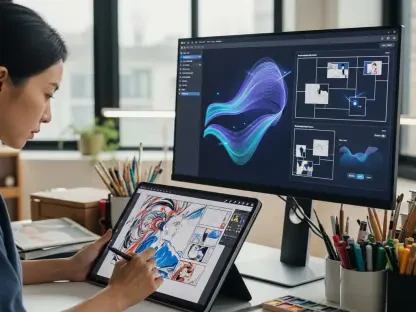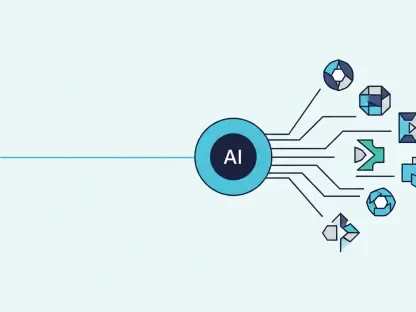The rapid advancements in artificial intelligence (AI) are fundamentally reshaping a multitude of industries, driven by the powerful capabilities of graphics processing units (GPUs) and neural processing units (NPUs). These technological marvels, initially developed for entirely different purposes, have now become indispensable tools for the AI revolution. As industries such as healthcare, automotive, entertainment, and edge computing vie to remain competitive and innovative, understanding and leveraging the intricacies of GPUs and NPUs has become critical. Their unique strengths and versatile applications are key to unlocking new potentials and efficiencies.
Dual Revolution in Computing
GPUs and NPUs represent a dual revolution in computing that has drastically transformed how industries approach complex computational tasks. Initially designed to render lifelike graphics in video games, GPUs have evolved remarkably, becoming indispensable for AI and machine learning (ML) model training. This evolution is largely due to their superior parallel processing capabilities, which allow them to handle tasks that demand extensive computational power effectively. The application range of GPUs now stretches far beyond gaming, making them vital components in fields such as scientific research, financial modeling, and more.
On the other hand, NPUs are specifically engineered for AI computations, excelling at performing lightweight, energy-efficient AI inferencing. This makes them particularly suitable for utilization in edge devices such as smartphones, Internet of Things (IoT) systems, and other compact electronic devices. The energy efficiency and specialized design of NPUs have also enabled significant strides in powering AI PCs, contributing to longer-lasting, quieter operations while ensuring continuous and efficient AI task processing. This dual revolution in computing underscores the pivotal role that both GPUs and NPUs play in advancing AI’s frontiers.
Market Trends and Projections
The ongoing evolution and adoption of GPUs and NPUs are clearly reflected in various industry forecasts and market trends. According to Gartner, the global revenue from NPUs—also known as AI semiconductors or AI chips—is anticipated to reach a whopping $71 billion in 2024, marking an impressive 33% increase from 2023. This substantial growth underscores the burgeoning demand for AI capabilities across a diverse array of sectors, highlighting how critical these technologies have become for modern enterprises aiming to leverage AI.
In addition, AI PCs are predicted to account for 22% of total PC shipments in 2024, with forecasts suggesting that they will eventually constitute 100% of enterprise purchases by 2026. This trend speaks volumes about the growing importance of AI in everyday computing and enterprise environments, further solidifying the relevance of GPUs and NPUs in the mainstream. Furthermore, the demand for GPUs, particularly those fueled by generative AI (GenAI), is also witnessing a significant rise. By the end of 2024, the market for these specialized server accelerators is expected to be valued at $21 billion, with expectations of growth to $33 billion by 2028. Such growth reflects the critical role that GPUs continue to play in advancing AI technologies and meeting the ever-increasing computational demands of AI research and applications.
Comparative Analysis of GPUs and NPUs
A comparative analysis of GPUs and NPUs reveals their unique strengths and tailored use cases, underscoring the need for strategic deployment depending on specific requirements. GPUs are unparalleled in tasks demanding raw computational power, such as AI model training and 3D rendering. Their ability to handle large-scale computations with remarkable efficiency makes them ideal for these applications. This is particularly evident in fields that require extensive data processing and high levels of graphical fidelity, such as gaming, animation, and scientific simulations.
In contrast, NPUs are optimized for repetitive AI tasks like voice recognition, boasting unmatched speed and efficiency with significantly lower power consumption. These attributes make NPUs highly suitable for deployment in edge devices that require stringent power and heat management, such as mobile phones and edge servers. The energy efficiency of NPUs makes them indispensable for applications where power constraints are a critical factor, ensuring that high-performance AI functionalities can be delivered without compromising on battery life or operational stability.
When considering energy efficiency, NPUs emerge as clear winners due to their design focused on power conservation. Conversely, GPUs tend to consume more energy, which can make them less suitable for energy-constrained environments. However, when it comes to scalability, GPUs excel in cloud environments, demonstrating seamless scalability across large data centers. NPUs, on the other hand, are tailored for edge computing scenarios, facilitating real-time decision-making in devices such as drones, vehicles, and various home automation systems. The distinct strengths of each technology highlight the importance of selecting the right processing unit based on specific application needs and operational contexts.
Diverse Applications Across Industries
The transformative capabilities of GPUs and NPUs extend well beyond mere hardware innovation, opening up a myriad of opportunities across various industries. In the gaming and creative sectors, GPUs have revolutionized game design by enabling advanced features like real-time ray tracing, making virtual environments nearly indistinguishable from reality. This technological leap has also powered high-definition rendering, streamlined animation workflows, and elevated video editing processes, significantly enhancing both speed and visual quality in creative endeavors.
In the realm of AI research and development, GPUs dominate due to their unparalleled computational power required for training AI models on vast datasets. However, NPUs are rapidly becoming essential for AI inferencing, allowing for real-time and efficient processing on compact devices. This is particularly important for applications such as natural language processing (NLP) and facial recognition, where real-time responses are crucial. The combination of GPUs and NPUs in AI workflows allows for optimized performance across different stages of AI model development and deployment.
In healthcare and life sciences, the integration of GPUs and NPUs is proving to be a game-changer. GPUs accelerate the analysis of large datasets, with a notable impact on image analysis for CT scans and other medical imaging techniques. On the other side, NPUs enhance real-time monitoring in wearable devices, providing continuous surveillance of patient vitals and contributing to more proactive and personalized healthcare solutions. The synergy between these technologies is driving significant advancements in patient care and medical research, offering new possibilities for diagnostic accuracy and treatment efficacy.
The automotive industry, particularly in the development of autonomous vehicles, sees a harmonious blend of both GPUs and NPUs. Complex navigation systems in self-driving cars rely heavily on GPUs for processing extensive sensor data, ensuring the vehicle can interpret its environment accurately. Meanwhile, NPUs assist in real-time decision-making processes, fostering safer and more intelligent autonomous mobility. This combined use of GPUs and NPUs is propelling the development of fully autonomous vehicles, bringing us closer to a future where AI-powered cars navigate our roads with unprecedented safety and efficiency.
Future Trajectories and Innovations
Looking ahead, the prominence of edge computing is set to rise significantly as real-time AI decision-making becomes increasingly crucial across various applications. One could anticipate the emergence of hybrid processors that combine the raw computational power of GPUs with the energy-efficient capabilities of NPUs. Such hybrid processors would enable seamless performance across a broad spectrum of workloads, revolutionizing applications ranging from precision parking in autonomous vehicles to creating immersive experiences in GPU-driven metaverse environments.
However, effectively implementing GPUs and NPUs poses numerous challenges for many organizations. This is where purpose-built edge computing solutions, such as Dell NativeEdge, come into play. Dell NativeEdge aims to democratize AI infrastructure by facilitating the seamless provisioning, deployment, and orchestration of applications across devices equipped with CPUs or GPUs. Employing zero-touch and zero-trust capabilities, such solutions enable organizations to overcome the complexities associated with AI deployment, accelerating innovation in areas like smart cities, healthcare, retail, and manufacturing.
Incorporating these advances into business practices enhances operational efficiency, reduces costs, and provides a competitive edge. Dell NativeEdge, for example, allows for intelligent systems to be deployed where they are most needed, ensuring that AI-driven solutions can be implemented effectively and sustainably. This approach not only addresses the existing challenges but also paves the way for future developments in AI, supporting continuous growth and adaptation in a rapidly evolving technological landscape.
Conclusion
The rapid advancements in artificial intelligence (AI) are dramatically transforming numerous industries, propelled by the powerful capabilities of graphics processing units (GPUs) and neural processing units (NPUs). Initially designed for tasks like rendering graphics and enhancing neural network computations, these technological marvels have now become essential catalysts for the AI revolution. Industries such as healthcare, automotive, entertainment, and edge computing are striving to stay competitive and innovative by harnessing the potential of GPUs and NPUs. Their unique strengths, such as parallel processing power and efficient machine learning capabilities, make them invaluable tools for unlocking new potentials and increasing operational efficiencies. In healthcare, for instance, GPUs and NPUs are accelerating the speed and accuracy of medical imaging analysis, leading to faster diagnoses. In automotive, they enable advancements in autonomous driving technologies. In entertainment, they enhance graphics rendering and real-time processing. In edge computing, they support real-time data analysis, allowing for quicker decision-making at the device level. Understanding and utilizing these processors is now critical for staying ahead in these rapidly evolving fields.









